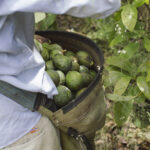Grapes in Charts: California sees low prices after Mexican supply surge

In this installment of the ‘In Charts' series, Luis Aragon of Agronometrics illustrates how the U.S. market is evolving. Each week, the series looks at a different horticultural commodity, focusing on a specific origin or topic visualizing the market factors that are driving change.
South and Central California are currently kicking off their table grape harvest season, which typically runs from July 10 to Oct. 15. As such, now is the perfect time to review how the category's volumes and prices have been behaving.
U.S. grape volumes and prices (non-organic)
(Source: USDA Market News via Agronometrics)
[Agronometrics users can view this chart with live updates here]
In late May we began observing a steady climb in table grape volumes (in orange). While these peaked two weeks ago, they have remained above the 20-million-mark ever since.
Looking at this year's shipments by origin, we can see that once Chile’s production began finishing up, Mexico promptly started supplying the market.
2019 Table grapes' weekly arrival volumes in the U.S. by origin (non-organic)
(Source: USDA Market News via Agronometrics)
[Agronometrics users can view this chart with live updates here]
What's more, Mexico has been supplying the market at an incredible rate. In fact, it has nearly doubled its weekly production volumes over last year's.
Mexico’s table grapes' volumes over last three seasons, (non-organic)
(Source: USDA Market News via Agronometrics)
[Agronometrics users can view this chart with live updates here]
Our article from early April predicted this boom in Mexican production. We also anticipated that the colder-than-usual temperatures in the country would lead to a delayed start to its season.
Due to these factors, we have seen a dramatic price drop of more than 50% in these past eight weeks, with a high of US$26.62 and a low of US$12.62 as seen in the following chart.
U.S. daily grape prices (non-organic)
(Source: USDA Market News via Agronometrics)
[Agronometrics users can view this chart with live updates here]
A sudden price drop is not atypical for the year’s 26-week half-way marker. However, with the vast volumes from Mexico saturating the market over the last couple of weeks, prices are significantly lower. Specifically, they have reached the lowest figure that we have seen in the past five years.
U.S. grapes' historical prices, (non-organic)
(Source: USDA Market News via Agronometrics)
[Agronometrics users can view this chart with live updates here]
On the other side of the border, industry sources are expecting this year to be similar to last, which saw prices spike after a late start, followed by low-prices running from week 38 through the end of the year.
So although the market may see relief in the near future, the end of the year could see even more low prices to come.
Central California’s grape volumes, (non-organic)
(Source: USDA Market News via Agronometrics)
[Agronometrics users can view this chart with live updates here]
In our ‘In Charts’ series, we work to tell some of the stories that are moving the industry. Feel free to take a look at the other articles by clicking here.
You can keep track of the markets daily through Agronometrics, a data visualization tool built to help the industry make sense of the huge amounts of data that professionals need to access to make informed decisions. If you found the information and the charts from this article useful, feel free to visit us at www.agronometrics.com where you can easily access these same graphs, or explore the other 23 fruits we currently track.




















































